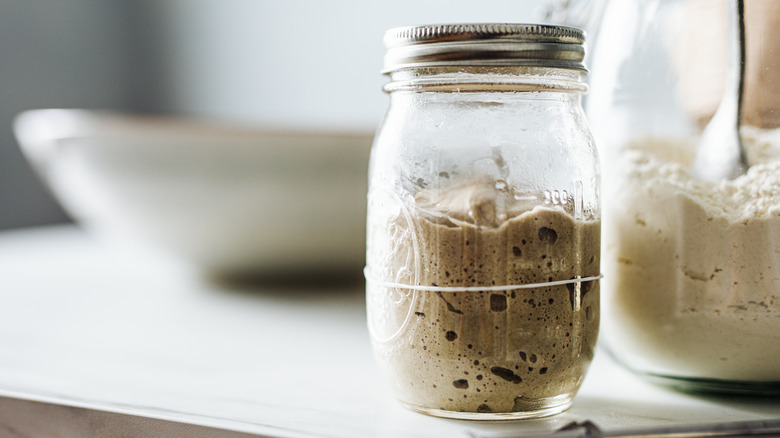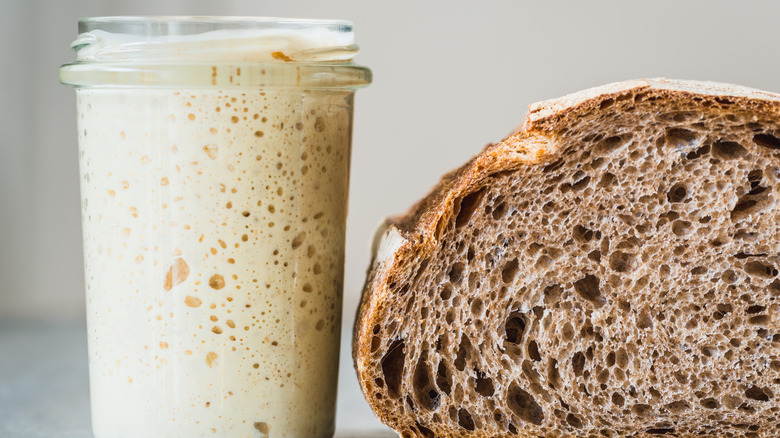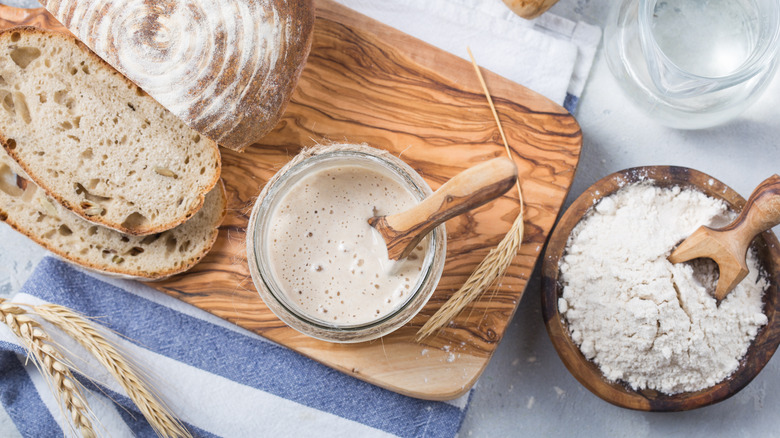The Rubber Band Tip For Accurately Marking Your Sourdough Starter
As far as baked goods go, sourdough practically has a baking cult devoted to its tangy flavor. Even with its popularity, though, sourdough also has a reputation for being difficult and particular. And so much of a successful sourdough process relies on getting your sourdough starter right.
If you haven't been fortunate enough to inherit a years-old starter from generations of bakers who came before you, it isn't hard to cultivate the iconic sourdough tang from scratch. Despite their reputation, sourdough starters don't have to be as intimidating as they're made out to be. The most basic sourdough starters are made from equal parts flour and water, mixed thoroughly in a clear, non-reactive container, then partially discarded and fed with more flour-water mixture on a regular schedule as the starter bubbles and grows.
Although the particulars will vary from recipe to recipe and environment to environment, this growth is an essential element. You have to know the level of your starter's growth to know when to feed it and when to use it — and unless you have an especially good memory for leavener levels, you'll need to indicate where your starter began so you can know how much it's risen. The easiest solution? Wrap a rubber band around your container to mark the level of the starter when you first make it and easily move it at the start of each feeding cycle. This popular trick ensures you can quickly and accurately see your starter's growth.
Feed a healthy sourdough starter to keep it growing
Sourdough starter is a natural leavener that precludes the need for commercial yeast in bread. Instead, sourdough starter works by cultivating a culture of microorganisms found in the flour, air, water, and even your hands — which is why the process and taste of sourdoughs vary widely in different environments. The microbes grow well because, as flour and water are mixed, amylases enzymes (or special proteins) convert starch molecules into sugar, which is the food that these microbes want to feast on. The variety of wild yeasts present consume the sugars in the flour and make carbon dioxide gas (where all those beautiful bubbles come from), and lactic and acetic acid-producing bacteria create the signature sour flavor profile.
That's the simplified version of a complex chemical reaction — but that's the reaction you're watching and the culture you're fostering as you feed your sourdough starter. Essentially, you feed the starter more flour and water to replenish the diminishing supply of sugars. The feeding schedule will be based on your starter's behavior, but you should feed it when it reaches its peak, the greatest height the starter reaches in the container, usually double or triple its original size. When you're constantly feeding the starter and discarding parts of it so that it doesn't overflow in the container, it's not easy to remember its original size. The rubber band is a quick visual guide that's easily adjusted, so you'll never miss a peak feeding.
Feed it right for a star sourdough starter
Sourdough starters should be fed by a ratio of starter to flour to water. Typically, this ratio should stay consistent as you feed it, but it doesn't always have to be; after all, the starter is alive, and it's going to need different things at different times depending on the conditions of its environment. Many bakers stick to a 1:1:1 ratio by weight — meaning that if you have 50 grams of starter, you add 50 grams of water and 50 grams of flour — but you may find that your starter is a little too runny and needs more flour or too thick and needs more water. It's important to keep it at the consistency of pancake batter. You can also increase the feeding ratio (more flour and water added) to slow down the time it takes the starter to reach its peak if it seems to be reaching peak too quickly.
Feeding at consistent times will also help you predict how long it will take from when it's fed to when it's risen and ready to use. As you feed it and keep it and watch that rubber band, you'll start to get to know your starter well and be able to make adjustments for your particular situation. When it comes time to bake sourdough bread with the starter, you'll use it when it's matured and at its peak — double or triple in size, bubbly, and emitting that delicious sour scent.


